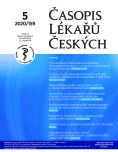Role of blood biomarkers in spontaneous intracerebral hemorrhage – a prospectively studied cohort of patients
Authors:
Jolana Mračková 1; Tereza Růžičková 2; Petr Ševčík 1; Marie Karlíková 3; Jan Mraček 4; Jiří Polívka 1
Authors‘ workplace:
Neurologická klinika LF UK a FN Plzeň
1; Neurologická klinika 2. LF UK a FN Motol, Praha
2; Oddělení imunochemické diagnostiky FN Plzeň
3; Neurochirurgická klinika LF UK a FN Plzeň
4
Published in:
Čas. Lék. čes. 2020; 159: 185-191
Category:
Original Articles
Overview
The study of blood biomarkers can offer new possibilities in diagnostics, prognostication, determination of etiology, and management of spontaneous intracerebral hemorrhage. The aim of our study was to assess the relationship between a panel of selected blood biomarkers and clinical and radiodiagnostic parameters in patients with spontaneous intracerebral hemorrhage. Primarily, the aim was to find a prognostic biomarker which could help in deciding on the optimal categorization of treatment. A total of 70 patients were prospectively included in this study.
As shown by our findings, higher levels of S100B protein are associated with larger hematoma volume. They predict hematoma progression and an unfavorable outcome. One other positive correlation was found between hematoma volume and interleukin 6, interleukin 10 and blood glucose. Lower levels of matrix metalloproteinase 9 are an independent prognostic factor for hematoma progression in patients with spontaneous intracerebral hemorrhage.
Keywords:
blood biomarkers – spontaneous intracerebral hemorrhage – prognostication – hematoma volume
Sources
-
Flaherty ML, Haverbusch M, Sekar P et al. Long-term mortality after intracerebral hemorrhage. Neurology 2006; 66 : 1182–1186.
-
Senn R, Elkind MS, Montaner J et al. Potential role of blood biomarkers in the management of nontraumatic intracerebral hemorrhage. Cerebrovasc Dis 2014; 38(6): 395–409.
-
Di Napoli M, Godoy DA, Campi V et al. C-reactive protein in intracerebral hemorrhage: time course, tissue localization, and prognosis. Neurology 2012; 79 : 690–699.
-
Misra S, Kumar A, Ram S et al. Role of copeptin as a biomarker for predicting outcome after intracerebral hemorrhage: a prospective cohort study. Abstract. J Neurol Sci 2017; 381 : 622.
-
Drucker E, Krapfenbauer K. Pitfalls and limitations in translation from biomarker discovery to clinical utility in predictive and personalised medicine. EPMA J 2013; 4(1): 7.
-
Abilleira S, Montaner J, Molina CA et al. Matrix metalloproteinase-9 concentration after spontaneous intracerebral hemorrhage. J Neurosurg 2003; 99 : 65–70.
-
Silva Y, Leira R, Tejada J et al. Molecular signatures of vascular injury are associated with early growth of intracerebral hemorrhage. Stroke 2005; 36 : 86–91.
-
Glushakova OY, Glushakov AV, Miller ER et al. Biomarkers for acute diagnosis and management of stroke in neurointensive care units. Brain Circ 2016; 2 : 28–47.
-
Hu YY, Dong XQ, Yu WH et al. Change in plasma S100B level after acute spontaneous basal ganglia hemorrhage. Shock 2010; 33 : 134–140.
-
Kubiak C, Mohamed W, Bhattacharya P. Admission blood glucose predicts high hematoma volume in intracerebral hemorrhage. Neurology 2013; 80: P05.229.
-
Bakradze E, McCullough LD, Staff I, Nouh A. Vitamin D deficiency correlates with stroke severity on presentation in intracerebral hemorrhage [abstract]. Stroke 2016; 47: ATP375.
-
Agnihotri S, Czap A, Staff I et al. Peripheral leukocyte counts and outcomes after intracerebral hemorrhage. J Neuroinflammation 2011; 8 : 160.
-
Di Napoli M, Godoy DA, Campi V et al. C-reactive protein level measurement improves mortality prediction when added to the spontaneous intracerebral hemorrhage score. Stroke 2011; 42 : 1230–1236.
-
Newman CG. Clarification of abc/2 rule for ICH volume. Stroke 2007; 38 : 862.
-
Delgado P, Alvarez Sabin J, Santamarina E et al. Plasma S100B level after acute spontaneous intracerebral hemorrhage. Stroke 2006; 37 : 2837–2839.
-
Castellazzi M, Tamborino C, De Santis G et al. Timing of serum active MMP-9 and MMP-2 levels in acute and subacute phases after spontaneous intracerebral hemorrhage. Acta Neurochir Suppl. 2010; 106 : 137–140.
-
Kreisel SH, Stroick M, Griebe M et al. True effects or bias? MMP-2 and MMP-9 serum concentrations after acute stroke. Cerebrovasc Dis 2016; 42 : 352–360.
-
Jonsson A, Hjalmarsson C, Falk P et al. Levels of matrix metalloproteinases differ in plasma and serum – aspects regarding analysis of biological markers in cancer. Br J Cancer 2016; 115(6): 703–706.
Labels
Addictology Allergology and clinical immunology Angiology Audiology Clinical biochemistry Dermatology & STDs Paediatric gastroenterology Paediatric surgery Paediatric cardiology Paediatric neurology Paediatric ENT Paediatric psychiatry Paediatric rheumatology Diabetology Pharmacy Vascular surgery Pain management Dental HygienistArticle was published in
Journal of Czech Physicians

Most read in this issue
- Production and use of convalescent plasma in COVID-19 treatment, taking into account the experience in the Central Millitary Hospital Prague
- A case of severe course of COVID-19 treated with experimental therapy
- Gambling products and their risk potential for gambling disorder
- Zapomenutý gastroenterolog?
